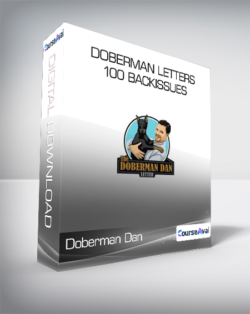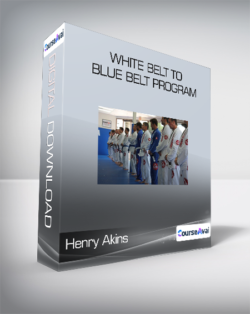Purchase Henry Akins – White Belt to Blue Belt Program courses at here with PRICE $499 $70Henry Akins – White Belt to Blue Belt ProgramScroll down to learn how you can get immediate access to this course!Here’s what people are saying about Henry Akins’ Hidden Jiu-Jitsu:“I’ve been a black belt since 2010, I’m still learning and… Henry makes me feel like a white belt. ”“Even as a black belt, training under Henry, it feels like I’m a white belt again in many ways…”“The thing I love about the whole, you know, Hidden Jiu-Jitsu style is… you got Jiu-Jitsu whether it’s sport, street, self-defense, MMA… I fight MMA… it works no matter what it is… in a gi, out of a gi, same grips, same pressure, same everything… it’s beautiful, and very useful.”“I can’t recommend him highly enough…”“What makes Henry’s teaching so different? Why is it SO powerful?”They say having skill in Jiu-Jitsu is like having super powers… but if you’ve never trained with Henry Akins, or witnessed the magic of Hidden Jiu-Jitsu for yourself, prepare to be mind blown…Because even within the Jiu-Jitsu community, there are depths of knowledge that have barely been explored by 99.9999% of even the most experienced black belts.Read on to begin your journey down the rabbit hole, and wake up from the matrix, to discover what’s truly possible with this beautiful art…The story of Henry’s Jiu-Jitsu journey is amazing, and reads like a template for Joseph Campbell’s “Hero’s Journey”.And to understand how it all happened, there’s an old saying that sets the stage perfectly:There’s an old saying.“In the land of the blind, the one eyed man is king.”Well, Henry had no idea just how true that saying was.Because when Henry started a massive seminar tour in 2014, there was no way he could have known that the last 19 years he’d spent training under Rickson Gracie would have led to something so incredible.But before we get to that, it’s worth mentioning how this all began.Remember when I said Henry’s story reads like a template for Joseph Campbell’s “hero’s journey”?Well, what I meant was, 23 years ago, after spending a week training with Rickson, Henry was so profoundly impressed with the incredible knowledge he was learning, he decided to leave everything he knew back home in Oklahoma…His home…His family…His friends…He even broke up with his girlfriend, because he knew in his soul he had to do this.Mastering this beautiful martial art called “Jiu-Jitsu” was his calling.And the rest of his story reads like a martial arts film.There’s even a short documentary about it online.But the highlights are: Henry is so dedicated, he becomes the school secretary for Rickson, and regularly spends 60-70 hours a week in the gym for almost two years straight.During that time, Henry becomes Rickson’s fastest blue belt in history, earning his promotion in only six months.Six months was incredible because it was absolutely unheard of for Rickson to give anyone a blue belt until they’d spend at least a solid 2 years with him.To this day, nobody has ever even come close to achieving their blue belt with Rickson so quickly.Why?Because, besides being one of the most conservative belt promoters in Jiu-Jitsu history, Rickson was teaching at a time when it was believed a blue belt in Jiu-Jitsu should be able to defeat a black belt in ANY other martial art.And Henry earned every bit of it, taking on challenge matches even at white belt.What a challenge match meant was: when people walked in off the street, wanting to test their mettle against the Jiu-Jitsu fighters, an informal MMA fight broke out right then and there.And it was up to the students to defend the honor of the gym.And to defend the honor of the gym, Henry was happy to take on the challenge.Because it was in those first challenge matches Henry truly discovered the “super powers” Jiu-Jitsu grants, those who have the discipline to train.Then, at only two years of training time, Henry was promoted to purple belt.And he still managed to be Rickson’s fastest ever black belt, even after blowing both of his knees out in competition at purple belt, and having to take time off.As if all that weren’t enough, even after being promoted to black belt, Henry continued to train the same disciplined way.And this went on for 19 years straight.Actually, it was pretty funny because we ran the numbers last year and realized just how crazy Henry’s dedication was.It breaks down like this: if you’ve ever heard of Maclom Gladwell’s “10,000 hour rule”… that it takes approximately 10,000 hours of deep practice to develop elite skill in a given discipline, where you’re competitive on the world stage…Well, when Henry started his seminar tour in 2014, he had spent an average of 4 hours a day training or teaching Jiu-Jitsu for the last 19 years… which, given two months out of the year for holidays, sick days, and vacation… adds up to 22,800 hours of training and teaching the purest Jiu-Jitsu known to man!!!More than double the 10,000 hours required for the best in the world to become competitive against all the other best in the world!!!Which explains perfectly why, when Henry started his seminar tour in 2014, to begin teaching on a bigger scale… Henry was shocked.Because what Henry discovered was:The Jiu-Jitsu handed down to him by Rickson Gracie, the Jiu-Jitsu he had dedicated 19 years of his life to at that point, practicing and teaching for 60-70 hours a week at times because it was so life-changing…Was nowhere to be found outside his home gym.I mean, nobody knew this stuff, that was just basic to Henry.It was like everywhere he went, everyone was completely blind to the hiddendetails that made Jiu-Jitsu so dominant and so effective in the first place.Henry said the whole thing reminded him of that game kids play called “telephone”, where one person whispers a message at the beginning of the line, and by the time the message reaches the end of the line, it’s changed completely.Sometimes, by the time the game is over, you can’t even recognize the original message.Well, it seemed the same thing had happened with Jiu-Jitsu, as it was passed down from teacher to teacher, and got further and further away from the source.In many places, it had been watered down and changed so much, it was like the effectiveness had been completely lost.And then something else happened.The more people Henry taught, the more he noticed them reacting strangely to what he was teaching.And it happened everywhere he went.For example, when Henry taught what he considered the fundamentals every blue belt should know… things like the basics of breaking posture from closed guard, the basics of weight distribution, the basics of connection and grip fighting, the basics of escapes and defense…All of the basics that were covered from white to blue belt at Henry’s home gym were treated like mind-blowing Jedi secrets nobody had ever seen!It didn’t take too long before Henry made a decision… because something had to be done.In Henry’s eyes, he had stumbled upon a true crisis.There was a true danger, it seemed, that the knowledge that made Jiu-Jitsu effective, efficient, and the most dominant self-defense system ever developed for a smaller person to defeat a larger person in unarmed combat…The hidden details, concepts and understanding that made Jiu-Jitsu feel like magic… might be lost forever.So Henry started “Hidden Jiu-Jitsu”.Hidden Jiu-Jitsu is an online library with the purpose of recording ALL the knowledge Henry has learned over his now 23 years of dedication to the art, so those who are blind to these hidden details and concepts, can finally see.And the White to Blue Belt program is the foundation of it all.To explain why the White to Blue program is so important as your foundation, there’s another old idea that has stood the test of time.And that idea is this: a wise man builds his house on a good foundation.Like a slab of rock.And when the rain comes down, and the rivers flood, and the wind blows against that house… it will stand, because it’s built on a solid foundation.But the foolish man builds his house on sand.And when the rain comes down, and the rivers flood, and the wind beats against that house, it will fall.And great is the fall of it.And that’s just about the state of so much of modern Jiu-Jitsu.For so many people, the foundation has been corrupted.Or was never built right in the first place.The basic concepts, the invisible details that make Jiu-Jitsu so devastatingly effective, and feel almost like magic…Have been lost for 99.999999% of modern Jiu-Jitsu fighters.And it shows when they fight.But all these benefits of having a solid foundation you can count on, do NOT have to be lost for YOU.Because you will find them ALL right here in Henry’s White to Blue Belt program.Because Henry has spent the last two years dedicating enormous amounts of his time to filming, editing and refining the official White to Blue Belt program.This is the same curriculum he taught as head instructor at the old gym on Pico Blvd in Los Angeles, including the official Rickson Gracie Blue Belt test.It’s the same program that made people believe a blue belt in Jiu-Jitsu could defeat a black belt in any other martial art.And if you have the guts and discipline to dedicate yourself to this program for the next 52 weeks, you will have a foundation set for the rest of your fighting career that is absolutely rock solid.With this foundation in place, you will be well on your way to making black belts feel like white belts when they roll with you.This is what so many of the 458 black belts from around the world who subscribe to Hidden Jiu-Jitsu (far more black belt subscribers than any other Jiu-Jitsu website we’re aware of, no matter how famous or accomplished the teacher is) have reported time and time again.And so many Jiu-Jitsu fighters who are not black belts have reported equally amazing results.But this program is NOT for everyone.If you don’t have what it takes to get the hell after it, and actually practice what Henry teaches… please stop reading right now.Get out of here, go on with your life, and stop kidding yourself.Procrastinators, half-assers, window shoppers… the rewards of the most effective martial art mankind has ever known… are not waiting for you.If you’re not willing to get off your ass, get into the gym, and practice these techniques, concepts and principles against live, resisting opponents, preferably who are bigger and stronger than you… go waste someone else’s time.This stuff is just too good to waste on lazy “can’t hackers”But… on the other hand…If you are serious about your training, if you have the mojo to stay committed day in and day out, and if you realize the value of learning directly from the source, so that you can become a true master of the art…Well, you could not possibly be in better hands.Henry is the real deal.Read on below for more details about exactly what you’ll learn inside the program, week by week.And remember, as you read this list… you may see the titles of moves you think you already know.But the details Henry teaches for these fundamentals are what make them magic.I promise you, you have NEVER seen the basics taught like this.But wait!Before we look at the list of 265 Units in the course…Check out just SOME of the 52+ weeks of BONUS videos Henry recorded, for the private White to Blue Belt Facebook Group, which you will get instant access to when you sign up!s of what you’ll learn and screenshots below!Remember, these are NOT the main course… every video you see in the list below is purely BONUS material!It’s unbelievable how much knowledge Henry was able to pack into these 52 weeks, and how simple, easy and quickly you’ll be able to use these techniques effectively!Here’s a list of just some of the exclusive bonus videos recorded for the private White to Blue Belt Facebook Group!Week 42 Bonus Video – Using the cross collar choke and armbar in combination from the closed guard.Why the cross collar choke in the first place? (Hint: if you get your initial grip the way I show here, it’s impossible to stop.)How to turn your chest to give yourself a major advantage, and take away your opponent’s ability to drive forward.What to do with your weight to make the cross collar 10x more effectiveWhat to do with the elbow of the arm that’s not attacking, that will help make this feel effortlessAnd of course, the two elements you need to easily take the arm if they use this common defense against the cross collarWeek 27 Bonus Video 3 – Timing the step for the elbow pluck armlock.What NOT to do with your hips, from scarf hold, if you want this armlock to workWhat you SHOULD do with your hips to prevent your opponent from getting his arm back – and how to do it.What you can do to develop your “feel” to get the perfect timing for the elbow pluck armlockWhy, if you have your hips in the right place, this timing trick always works, no matter who you’re fightingWhen you should NOT go for the elbow pluck armlock – and why.Week 17 Bonus – Using the Cross Collar Choke and transitioning to the AmericanaHow to get your opponent’s arm to the ground to attack the Americana with your elbow instead of your hand – and why you should always do this.How to quickly transform your cross collar choke grip – to the perfect setup for the AmericanaWhy attacking the cross collar is so perfect for opening up the AmericanaHow to connect your arm to your opponent’s arm that gives you amazing control – without even using your fingersWhat you need to do with your hand to transition from the Cross Collar to the Americana to maintain control throughout the entire movementHow to use your entire body weight against his arm, instead of battling arm strength vs arm strengthWeek 8 Bonus Video – Clearing the gi grips to clinch – and 3 very effective takedownsHow to deal with an opponent holding you out at arm’s length, when you can’t connect your hip, you can’t catch his ankle, and you can’t get close enough to do any of the other traditional takedownsHow to move through to the back so you don’t get caught in the guillotineHow to secure the double leg, if you’d prefer that to taking the backHow to make sure you don’t fall into his guard when you go for the double legHow to trap your opponent’s hand to give you even more controlHow to set up the single leg from the side, that Demian Maia uses all the timeWhy the single leg is not done effectively by driving forward, and what to do insteadWeek 14 Bonus Video 1 – 100% Pushing drill with no techniqueA critical drill that should be constantly practiced – from white belt to black belt – your whole careerHow this applies to untrained opponents, and why this is so important in that contextWhy this is so important to do often – and a demo of how easy it is for an untrained opponent to throw you right off the mount if this skill isn’t razor sharpA demo of how effective all 4 methods of maintaining the mount can be when you do practice them regularlyWhy this is such a good thing to know if you’re fighting somebody bigger than you (hint: watch how fast the person on bottom gets tired when you can maintain mount for even just one minute!)Week 45 Bonus – Game changing concept for open guardTwo adjustments you can make to make it impossible to pass your open guardHow, specifically, to do each one of these adjustments in different scenarios, and how to link them with sweeps and back takes, so you can lay irresistible traps to advance your position effortlessly.What element does he need to pass your guard? It’s actually just this one thing, that’s so easy to take away from your opponent, once you understand, no matter what awkward phase of the guard pass you may find yourself in.If you fail with one leg, how to make the other leg to the same job before it’s too late.Why it doesn’t matter which side they pass to, if you understand how to use BOTH legs to make the timing work for you (hint: it’s very similar to balancing an equation in algebra, and will be easy once you get the hang of it. Devastating to them though.)Week 38 bonus – Taking the back after countering the hip bump sweepOnce you know how to shut down the hip bump sweep (covered in another video in this course) you can easily turn any attempt at a hip bump into an easy back takeWhat to do with your knees to make the transition to the back smooth as silkWhat to do with your attacking hand, so you can sneak in your neck attack before your opponent even knows what’s happeningWhat to do before you transition to make sure it’s effortlessWhy you sometimes might need to bring your leg back before you step over to take the back – and how to do it wellPisao – Front Kick – Bonus Video !!!!The most important thing you MUST do if you want to use the Pisao effectively (hint: it has to do with how you land. Mess this up, and you may as well not use it at all.)What you need to do with your weight as you kick, and why so many people screw this up.How this kick can do major damage – if you want it toWhy you don’t need to do any damage at all for this to be your most useful tool for closing the distanceHow my friend Anthony Hardonk, an absolute master from the most decorated kickboxing gym in the world, adds an element to this kick to make it 10x more devastatingWeek 43 Bonus – Combining the kimura, guillotine and hip bump sweepHow to combine each of these attacks, in any order, based on your opponent’s reactionsHow to force your opponent to give you the reaction you need to set up your attacksWhat you need to do with your hips if you’re going for the guillotine in any of these transitions (this will improve your guillotine grip ten fold)The detail almost everyone misses for the hip bump sweep you need to know to make it work better and more oftenThe timing for when to go for the kimura, and how to set it upWeek 46 Bonus Video – Making your opponent fall forwardWhy you never, ever allow your opponent to stack you when they stand (and what to do instead)What to do with your hands to make them fall forward (not backward like the double ankle grab sweep, but forward, back down into your guard)How to make your opponent work like hell just to stay standing (every time you can make your opponent waste energy, and relax while you do it, is a win for you. Here’s how to score a big win from the closed guard when they go to stand).What you need to know about a giant rock that will help you visualize the right motion for this movement.The basic attack options once they fall back down that are yours for the taking.Week 27 Bonus 1 – The super chill position (cross side with the underhook) and double attackWhy you want your outside arm pinching behind his elbow, hand against your face, for the super-chill position – especially in a fight (hint: nobody likes being punched in the face or poked in the eyesWhat to do with your inside arm to increase your control of your opponent dramaticallyA small adjustment you can make against your opponent’s trapped arm that will increase the pressure for the armlock substantially – and make the super chill that much more uncomfortable – for them! You, on the other hand, will be ready to take a nap the whole time…How to finish the elbow pluck armlock with maximum leverageHow to either reach behind your own head to attack the americana, or just take advantage of him attacking youWeek 27 bonus 3 – Timing the step for the elbow pluck armlockWhat NOT to do with your hips, from scarf hold, if you want this armlock to workWhat you SHOULD do with your hips to prevent your opponent from getting his arm backWhat you can do to develop your feel to get the perfect timing for the elbow pluck armlockWhy, if you have your hips in the right place, this timing trick always works, no matter who you’re fightingWhen you should NOT go for the elbow pluck armlockWeek 20 Bonus – Using the umpa after defending the Kimura grip from mountA clever escape from the kimura grip that immediately clears your arm from any danger, and sets up a perfect situation your can use the umpa to take the top positionWhat to do with your head to get the perfect angle for this escapeWhat to do with your trapped arm as you move to keep it safeWhat to do with your legs to make it all happen smoothlyThe direction to bridge once you’re in the “safe” positionWeek 28 Bonus 1 – Breaking the grip when they grab to defend the Kimura and switching to the straight armlockHow to take the arm quickly, easily and effectively (meaning he can do nothing about it) when your opponent is grabbing his own legWhat to do instead, when your opponent is grabbing his belt rather than his leg (the grip is harder to break, so there’s another armlock we can do – just as devastating)What you need to do with your knee when switching to the straight armlock, when your opponent is grabbing his belt… and why this is so crucialWhich angle to fall at, when you go for the straight armlock, that makes all the difference in the worldHow to shut down the hitchhiker escape fast, as you finish the straight armlockWeek 25 Bonus 3 – Preventing the back take from the step over mount.3 reasons you should never lead with your knee when going for the step over mountWhy it’s so easy for your opponent to take your back if you’re light on your rear leg as you step overWhere to slide your rear knee to really tighten this upHow to be heavy on your rear leg so you don’t get your back takenWhat to lead with instead of your knee as you step over that will prevent all of these problemsWhat to do with the heel of the foot that steps overWeek 7 Bonus Video 2 – Countering the High PummelBeing able to use the high pummel is rare, but in case you face someone who does use the high pummel against you, here’s how to counter it so you don’t end up in a stalemateThe two things you must do together to create space to pummel inWhy your elbow is the key to this movement, even though you’re really using your bodyweight and not your armWhat to do with your hand AFTER you move your elbowOnce you understand this, the high pummel will be easy for you to counterWeek 14 – Bonus Video Maintaining the mount against pushing.Pushing from the bottom of the mount is always a mistake – here’s how to make them pay for it.What you need to do – with both hands – to maintain base, in all the different situationsWhat to do with your hips to soak up the space, to set up the armlockWhat to do with your knees to finish the armlock super tight, and super fastHow to counter the push and simply maintain the position – without a submission (this is a great strategy if you’re looking to gas your opponent)Week 15 Bonus Video 3 – Guillotine from a bear hug in mount positionHow to take one of the most common defenses for strikes from the mount – the bear hug – into a fatal mistake, and finish an easy guillotine, because the moment he bear hugs you, he’s practically giving you the guillotine!How to base out to give yourself a ton of space to get your grip (hint: don’t use the other arm)What to do with your elbows to get maximum leverageHow to clear your opponent’s head to easily set up the guillotine, without using arm strengthWhat to do with your own head when setting up the guillotine from the mount – and whyWeek 10 Bonus Video – Solo Drill for the Sit Down SweepWhy the sit down sweep is one of the most powerful takedowns you can developHow the mechanics of the sit down sweep are unique – in that it’s one of the few takedowns you can develop real competence in with a solo drillWhy your back should never hit the ground with this sweep – and how to roll insteadWhy your legs don’t move during this drillHow to use rotation – rather than pulling strength – to achieve this sweep more effectivelyWeek 6 Bonus Video – Standing in Base Pushing and Pulling Drill.Why you cannot practice this drill enough – it’s that important.How to stand in relation to your opponent, to give yourself strong balance in ALL directionsThe one small detail with your hips that will make you like an unmovable wall – without using any muscle or strength whatsoeverA second way to use your hips that makes you even MORE difficult to move, and will help you stay perfectly balanced no matter whether you are moving, or your opponent is movingThe understanding you need about your head and shoulders, in relation to your hips, that will help you shut down SO many takedownsHow to take an easy ankle pick if he insists on pulling you so hard you have to go low to keep your baseWeek 12 Bonus – Using the Teeter Totter and the 4 ways of getting back up to the feet.How to use kicks to maintain distance as you’re trying to get to your feet from the open guard, when strikes are in playThe first, and most simple option you have to get back to your feet, once you’ve created some distance – and one reason you may not want to use this optionHow to use your feet to get more out of your kicksWhere to kick on your opponent’s legs for maximum effectThe second option you have to get up, that gives you a little more distanceA third option to get up, that works for MMA (but you may want to be careful about in a fight without rules), and helps you close the distance fastestThe last, and safest, option of all of these, that creates massive distance quicklyClick this video below to listen to what Ivan and Guy Ritchie, director of “Sherlock Holmes”, “Snatch and “Lock, Stock and Two Smoking Barrels” have to say!!!Week 7 Bonus Video 2 – Getting comfortable with the George Foreman defense and walking in baseWhy I prefer the George Forman defense to some of the other methods of protecting the head while clinchingWhy it’s better to use heavy open hand strikes to train this drillHow this drill will train you to walk in base perfectly, so you’re totally solid, from every angle, as you moveHow this drill will help you develop absolute super powers for judging distance (you’ll see what I mean when you watch the demo)How to time your underhooks so you’re effective – if you get this wrong, you can easily be knocked out and/or lose your clinchWeek 7 Bonus Video 4 – Connection drill when ClinchingA fantastic drill to develop your ability to stay connected to your opponent when clinchingWhy we don’t grab our opponent or establish underhooks for this drill – and how it will help you become a much better fighterHow this will help you develop such strong base, you will be like a giant, unmovable rock in every direction.How to use your footwork to follow your opponent even if he’s suddenly faster than youHow this drill will allow you to be an inescapable force of Jiu-Jitsu nature as soon as you decide to clinch (there will be no escape for your opponent once you get the hang of this, even if you can’t get underhooks right away)Week 13 Bonus Video 1 – Von Flue ChokeWhen you pass to crosside and your opponent wraps your neck, here’s how to turn it into an easy finishHow to trap your opponent’s arm – the one wrapping your neck – to instantly shift to the feeling of control – so they begin to panicWhat to do with your feet – and knees – to prevent the guard recovery, as you slide all of your weight directly onto your opponent’s neckWhat to do with your shoulder – so that even if they tuck their chin to defend the choke, it won’t matterHow to use both hands together if your opponent begins to turn on youWeek 23 Bonus 1 – The importance of staying perpendicular to flatten your opponent out.Secrets of the angle – why you want to be perpendicular to your opponent from cross side, and where to put your chin to make this automaticA detail you should understand about the shrimp escape that’s not often talked about, that will improve your ability to control your opponent from cross side immenselyWhich parts of your body that should touch the ground from crosside, and which should notWhy you should never have your legs fully extended from crossideA simple adjustment you can use to make sure you never have your legs fully extended from crossideWeek 32 Bonus 1 – Using the movements – guard recovery, and going to your knees – in combination with each otherWhen to use guard recovery, vs when to use going to your knees, based on the direction your opponent is doingFootage of one of the most beautiful gyms I’ve ever seenWhat you should be paying attention to – especially with your opponent’s arms – to let you know when it’s time to use each escapeHow to bait your opponent into each escape, so you can use the other oneWeek 28 bonus 2 – Using the two options to mount to set up the Kimura, straight armlock and super chill position.How to begin with the end in mind – and use different positional “bait” to force your opponent to give you want you want to set up your attacksHow to achieve the underhook, and what you should do with your hips and legs, to make getting to the super-chill position easy and simpleHow to use knee on belly for an easy kimura, and what to look for when you do.The reason you want the overhook when you decide to switch your legs to mountThe one thing you should NOT forget to do, after you have your kimura grip, and you switch your leg position to finishWeek 44 – Preventing getting stacked from triangle using shoulder walkWhy it’s so important to be able to prevent getting stacked (hint: has nothing to do with finishing the triangle).The two details you need to make this shoulder walk work, so you don’t eat your own knee or get stacked anyway, even though you’re making a good effort to walk backwardHow to use the shrimp movement to achieve this faster and keep them guessing on the right angle to drive throughWhat to do with your legs as you shoulder walk to make this infinitely more difficult for your opponent to deal withHow this will increase your longevity in Jiu-Jitsu, and prevent one of the most devastating injuries that forces people to quit Jiu-Jitsu altogether!Week 41 bonus 2 – Preventing the first leg from coming upThe specific elements your opponent needs to stand up in your closed guard – and how to take them away!What to do with your heels to increase your pressure on his hipsWhat to do with your knees to make it feel like he’s helplessly stuck when he tries to standHow to use this technique to force your opponent back down into the guardHow to make your opponent start giving you your attacks from hereWeek 44 – Bonus – Preventing getting picked up from triangle or armlockA great example of how an absolute Jiu-Jitsu beast was completely destroyed by this slam in a famous MMA fight – and why it’s so important to prevent.Why you can easily be gravely injured or even killed if you don’t know how to stop this.Why connecting to the leg alone is not enough, and what you need to do to prevent your face from being smashed by your opponent’s knee.Demos of armlock and triangle, so you can see the different anglesWhere you should put your hand that connects to your opponent’s leg to make things much better for you, and much worse for him!Week 29 Bonus – Rolling and paper cutterOver 10 minutes of footage of me rolling with two of my blue belts – and narrating every step of the way – to show you how the details of how to secure the paper cutter choke and also…Why it’s a good idea, from time to time, to roll with an agenda. In this video I was after a single submission – and doing this will test every aspect of your game, from positional control, to transitions, to the finish.How your opponents reactions will change when they know what you’re up toPurchase Henry Akins – White Belt to Blue Belt Program courses at here with PRICE $499 $70
 Doberman Dan – Doberman Letters 100 Backissues
₹9,462.00
Doberman Dan – Doberman Letters 100 Backissues
₹9,462.00
 Aff Playbook – Long-Term Affiliate Marketing Strategies
₹11,620.00
Aff Playbook – Long-Term Affiliate Marketing Strategies
₹11,620.00
Henry Akins – White Belt to Blue Belt Program
₹11,620.00






